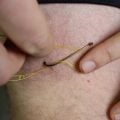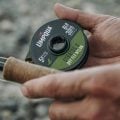How to Tie John Barr’s Meat Whistle Streamer
“This is John Barr’s Meat Whistle streamer, an extremely functional and adaptable pattern. During my trip to Patagonia last year, the Meat Whistle and variations of it were the preferred choice for hammering the banks and dredging deeper pools. The results were hard to argue with. We used a number of different colors and versions, all were a ton of fun to fish and really got the job done.
To tie the Meat Whistle, I start with a size 2 Mustad jig hook. I pair this with a large size copper-colored tungsten cone head. Insert the hook point into the small hole of the cone then get the assembly firmly secured in the jaws of your tying vise.
The tail and much of the body are created using a single rabbit Zonker strip, here, a rusty brown color. With the fur angling rearward, measure to form a tail about a hook shank in length and transfer that measurement to the hook point. Stab the hide side of the strip then remove your hook from the tying vise and replace it so the Zonker strip can be oriented to the underside of the hook shank. Use a little moisture to sweep the entire strip rearward out of the way.
For thread, I’ve loaded a bobbin with a spool of rusty brown UTC 140 Denier. Get your thread started on the hook shank at the back edge of the cone and take a few wraps rearward before snipping off the tag.
Copper brown pearl sparkle braid is used to add a bit of shimmer to the otherwise dull body of the fly. A 2 card-width length is just enough for this size 2 hook. Place one end of the braid above your tying thread and take nice tight wraps rearward to anchor the material all the way back to the start of the bend. Then wrap forward to the initial tie-in point. Get hold of the braid and start making touching wraps with it up the shank. Be sure to keep tension on the braid or the whole thing is very likely to come unraveled. When you reach your tying thread, use it to secure the braid then snip the excess off close.
Pull the long part of the Zonker strip forward and create a space in the fur at your tying thread. Take several wraps to anchor the strip then make sure everything is tight and looking good. Use your scissors to snip the excess Zonker strip off close. Do your best to remove as much as possible, being careful not to snip your tying thread in the process. Once you’re happy with the results, take a few extra turns to further bind the rabbit down.
Mr. Barr’s original pattern called for a wire rib to segment the body and to bind down the Zonker strip, but I’ve found the pattern much easier to tie without it. Two strands of copper-colored Flashabou are used to give the fly a little bling. Find the midpoint of the two strands and secure it to the near side of the hook with a few wraps of tying thread. Then secure the other half of the material to the far side of the hook.
Pumpkin barred silli legs are used to enhance the fly’s movement. Two full-length pieces are all that’s needed. As you did with the Flashabou, secure the midpoint to the near side of the hook then relocate two strands to the far side and bind them down. All these long strands can get a little unruly but a spring loaded hair clip does an admirable job of corralling them.
You can use marabou for the collar of the fly if you like but I’ve found grizzly saddle hackle, here in brown, to be much easier to tie in and just as effective. Select a single, webby feather and pull it free from the skin. Strip off the lower fibers to the point where the stem begins to markedly thin, then snip the butt end off close. Pull down a few fibers on either side of the stem and trim them to form a small triangular tie-in anchor. Give your bobbin a clockwise spin to cord up and strengthen your tying thread then use it to secure that tie-in anchor to the near side of the hook, with the shiny side of the feather facing you. Then advance your thread to the back edge of the cone. Get hold of the hackle feather and fold it by bending the stem through the fingertips of your left hand. This isn’t essential but does help to keep the majority of the hackle fibers pointed rearward, as you take touching wraps forward all the way up to the back edge of the cone. Once there, use your tying thread to secure the hackle tip then snip the excess off close. Push the cone rearward to preview the final result. If everything looks ok, take a few more thread wraps then do a couple of 4 to 5 turn whip finishes to make sure it won’t come unraveled. Then snip your thread free.
Start your tying thread on the hook between the eye and the front of the cone. Use the thread and tag end to push the cone rearward as you take wraps to create a thread dam that holds the cone back. The cone should angle the hackle even further rearward. With the cone held in this position, snip the tag end of your tying thread off close.
Rather than doing a whip finish to secure the tying thread, I prefer to reach for the UV cure resin. Just the smallest drop placed on a sticky pad is all that’s needed. A fine-tipped bodkin works very well for applying a little bit to the thread wraps and front edge of the cone. Give the area an ample shot of UV light to cure the resin. Once it’s hardened, use the tips of your scissors to snip your tying thread free. It’s a good idea to pick up another drop or two of resin to thoroughly coat the thread wraps and fill in any spaces at the front edge of the cone. Make sure to give the whole area a thorough bath with UV light. These flies really take a beating and you want to make sure the resin is completely cured.
After removing the hair clip, let the silli legs and Flashabou drop down beneath the fly. You can then trim them off all at once so they’ll extend about the same length as the tail.
I know I’ve taken some pretty significant liberties in terms of John Barr’s original pattern but this is what works for me. Meat Whistles ride hook point up, have a ton of motion, and imitate several food sources for a variety of fish species. And yes, try them in different colors and sizes as well.”
How to Tie Jim Rusher's Steelhead Nymph
How to Tie Just Another Euro-Jig











